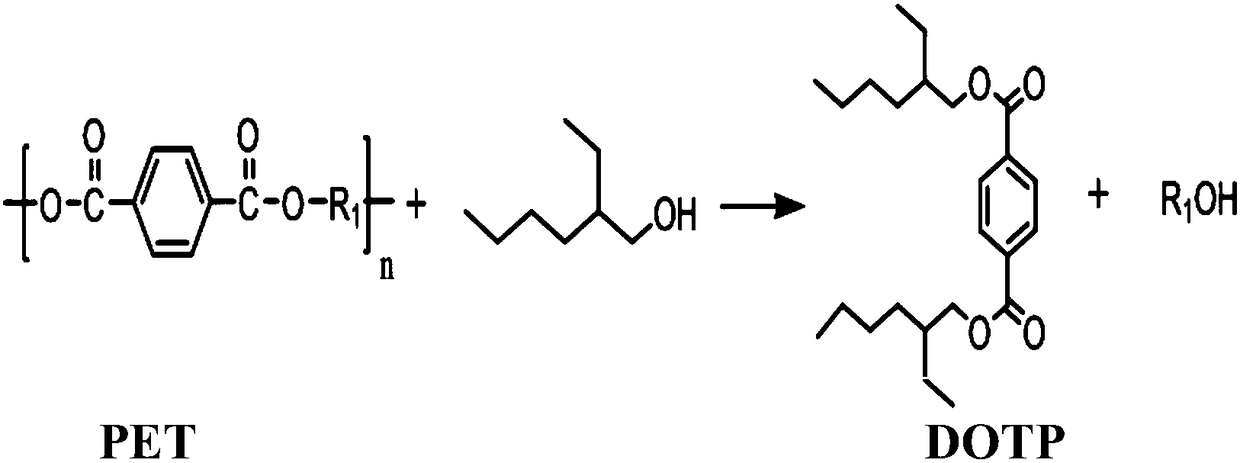Method for preparing diisooctyl terephthalate through catalyzing alcoholysis of polyethylene terephthalate by choline eutectic ionic liquid
A technology of polyethylene terephthalate and poly-pair, which is applied in the preparation of ester group and hydroxyl group, etc., can solve the problems of slow reaction, unstable catalyst and long catalyst activation time.
- Summary
- Abstract
- Description
- Claims
- Application Information
AI Technical Summary
Problems solved by technology
Method used
Image
Examples
Embodiment 1
[0024] Using PET granules as raw material, 5.0g PET raw material, 17.0g isooctyl alcohol and 0.25g choline deep eutectic ionic liquid catalyst were added successively in a 50ml three-necked round-bottomed flask. The raw materials for the synthesis catalyst were choline chloride and zinc acetate. The molar ratio is 1:2, and the synthesis conditions are 70°C, 120min. The reaction temperature was controlled at 175° C. under normal pressure, condensed and refluxed for 60 minutes, and then cooled to room temperature. Under these conditions, the degradation rate of PET is 100%, and the selectivity of di-isooctyl terephthalate (DOTP) is 78.2%.
Embodiment 2
[0026] Using PET granules as raw material, 5.0g PET raw material, 17.0g isooctyl alcohol and 0.25g choline deep eutectic ionic liquid catalyst were added successively in a 50ml three-necked round-bottomed flask. The raw materials for the synthesis catalyst were choline chloride and zinc acetate. The molar ratio is 1:1.5, and the synthesis conditions are 70°C, 120min. The reaction temperature was controlled at 185° C. under normal pressure, condensed and refluxed for 60 minutes, and then cooled to room temperature. Under these conditions, the degradation rate of PET is 100%, and the selectivity of di-isooctyl terephthalate (DOTP) is 82.5%.
Embodiment 3
[0028] Using PET granules as raw material, 5.0g PET raw material, 17.0g isooctyl alcohol and 0.25g choline deep eutectic ionic liquid catalyst were added successively in a 50ml three-necked round-bottomed flask. The raw materials for the synthesis catalyst were choline chloride and zinc acetate. The molar ratio is 1:0.25, and the synthesis conditions are 50°C, 240min. The reaction temperature was controlled at 185° C. under normal pressure, condensed and refluxed for 60 minutes, and then cooled to room temperature. Under these conditions, the degradation rate of PET is 99.2%, and the selectivity of di-isooctyl terephthalate (DOTP) is 79.4%.
PUM
 Login to View More
Login to View More Abstract
Description
Claims
Application Information
 Login to View More
Login to View More - R&D
- Intellectual Property
- Life Sciences
- Materials
- Tech Scout
- Unparalleled Data Quality
- Higher Quality Content
- 60% Fewer Hallucinations
Browse by: Latest US Patents, China's latest patents, Technical Efficacy Thesaurus, Application Domain, Technology Topic, Popular Technical Reports.
© 2025 PatSnap. All rights reserved.Legal|Privacy policy|Modern Slavery Act Transparency Statement|Sitemap|About US| Contact US: help@patsnap.com



